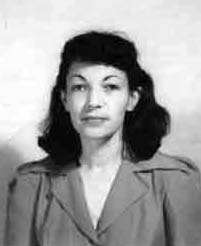Sara Kathryn Arledge
Sara Kathryn Arledge (September 28, 1911 – 1998) was an American artist and filmmaker acknowledged as "one of the foremothers of the American experimental cinema."[1]
Sara Kathryn Arledge | |
|---|---|
 | |
| Born | September 28, 1911 Mojave, California |
| Died | 1998 (aged 86–87) |
| Nationality | American |
| Education | University of California Los Angeles, Columbia University |
| Known for | Experimental Film |
Notable work | Introspection (1946) |
Early life and education
Born in Mojave, California, Arledge received a Bachelor of Education in Art from the University of California, Los Angeles in 1936. She also attended Columbia University and studied painting at the Barnes Foundation.[2] She taught at the Department of Art at the University of Oklahoma from 1943–44, and at the University of Arizona, Tucson from 1945–46.[1]
Work
Her most recognized films were Introspection (1941–47) and What Is A Man? (1958).[3] Introspection was the first abstract dance film made in the United States, and it pioneered the "cine-dance" genre (along with Maya Deren's A Study in Choreography for Camera, released in 1946).[4]
Arledge also painted throughout her career and worked in the media of glass slide transparencies, which combined attributes of painting and filmmaking that interested her. According to film historian David E. James, "almost all the European avant-garde filmmakers of the 1920s were visual artists," and Arledge was one of the only Los Angeles visual artists to continue experimenting with the film medium after the 1920s.[5] She also wrote about experimental film history; her essay "The Experimental Film: A New Art in Transition" was published in Arizona Quarterly 3, no. 2 (Summer 1947).[5]
Arledge was noted for her glass slide transparencies created by layering pieces of multicolored stage-light gelatins and baking them on glass slides. The artist then draws on the surface of the gels with a variety of objects and seals the images by covering them with another set of glass slides.[6] The fragile nature of this medium led her to make her "stabile color films" between 1978 and 1980 that integrated the slides and sound recordings in such works as Tender Images, Interior Garden I, Interior Garden II, and Iridium Sinus (Cave of the Rainbows).
Legacy
Filmmaker Barbara Hammer described how Arledge "creates films that combine structural and painterly concerns guided by the emotions" and "represents for us the filmmaker as a whole person, as unified woman, as liver/artist".[7] Her paintings were first exhibited posthumously in the exhibition "The Making of Personal Theory: Mysticism and Metaphysics in the Work of Sara Kathryn Arledge, Charles Irvin, and Jim Shaw," curated by Irene Tsatsos at the Armory Center for the Arts in Pasadena, California.[8]
References
- Dixon, Wheeler (1997). The exploding eye: a re-visionary history of 1960's American experimental Cinema. Albany, New York: State University of New York Press, Albany. pp. 11–13. ISBN 978-0-7914-3565-6.
- Posner, Bruce (January 1, 2001). Unseen Cinema: Early American Avant-garde Film 1893-1941. Anthology Film Archives. ISBN 9780962818172.
- "Sara Kathryn Arledge". Alternative Projections. Los Angeles Filmforum. Retrieved 8 March 2015.
- "Canyon Cinema : Filmmaker". canyoncinema.com. Retrieved 2018-09-06.
- James, David E. (2005). "Artists as Filmmakers in Los Angeles". October. 112: 111–127. doi:10.1162/0162287054223936. JSTOR 3397647.
- Anker, Steve; Geritz, Kathy; Seid, Steve; Cannon, Terry (2010). Radical Light: Alternative Film and Video in the San Francisco Bay Area, 1945 - 2000. University of California Press, Berkeley. ISBN 9780520947252.
- Hammer, Barbara (1980–81). "Sara Kathryn Arledge". Cinemanews. San Francisco, California: The Foundation for Art in Cinema, 1963-1984, Larkspur, California (6/1).
- "The Making of Personal Theory: Mysticism and Metaphysics in the Work of Sara Kathryn Arledge, Charles Irvin, and Jim Shaw". Armory Center for the Arts. Retrieved 8 March 2015.